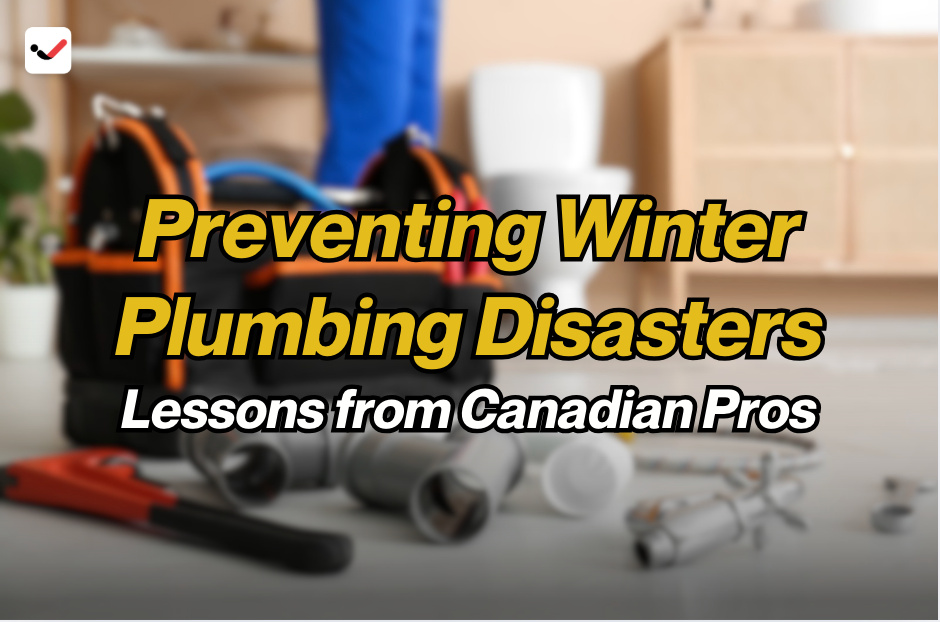Preventing Winter Plumbing Disasters: Lessons from Canadian Pros
Preventing Winter Plumbing Disasters: Lessons from Canadian Pros

Canadian winters can be brutal, and your home’s plumbing system is one of the first things to suffer when the temperature drops. Frozen pipes, burst lines, and water damage are all too common during the colder months. These problems aren’t just annoying—they can cost thousands of dollars to fix. That’s why professional plumbers across Canada stress the importance of winter plumbing preparation before the first deep freeze hits.
The good news is that most winter plumbing disasters are preventable. Canadian plumbing experts have learned the hard way what works and what doesn’t when it comes to cold weather. Their advice can help homeowners protect pipes, avoid emergency repairs, and keep water flowing safely all season long. This article will cover proven tips and tricks from experienced plumbers to help you winter-proof your home and avoid costly damage.
1. Insulate Pipes in Cold Areas
One of the biggest causes of frozen pipes is lack of insulation. Pipes running through basements, crawl spaces, attics, garages, and exterior walls are most at risk. Canadian plumbers recommend insulating these pipes with foam tubing or heat tape to keep them above freezing temperatures.
Pipe insulation is cheap and easy to install. It creates a barrier that helps retain heat, even in unheated areas. Focus on exposed copper or PVC pipes, especially those close to outside walls or windows. This small step can prevent frozen pipes and water line bursts during extreme cold.
2. Seal Gaps and Cracks
Cold air sneaks into homes through gaps around windows, doors, vents, and where pipes enter the house. Sealing these openings with caulk, weatherstripping, or spray foam keeps the cold out and the heat in.
Canadian plumbing pros often find that drafts near plumbing fixtures—like under sinks or behind toilets—lead to frozen pipes. Walk around your home and check for cold spots or airflow near water lines. Stopping those drafts early can make a big difference when temperatures drop below zero.
3. Disconnect and Drain Outdoor Hoses
Leaving hoses connected in winter is a common mistake. When water is left inside hoses, it can freeze and back up into the faucet and indoor plumbing. This often causes pipe bursts inside the wall.
To prevent this, Canadian homeowners should disconnect, drain, and store hoses before winter. Shut off the outdoor faucet from the inside valve (if your home has one), then open the outside tap to let any leftover water drain out. Use insulated faucet covers for extra protection against freezing.
4. Shut Off and Drain Outdoor Faucets
Outdoor plumbing is highly vulnerable in cold weather. Canadian plumbers recommend turning off the water supply to outdoor faucets completely. After shutting off the inside valve, open the faucet outside to drain all remaining water.
For extra protection, install frost-free hose bibs. These special outdoor faucets are designed to shut off water flow well inside the house, reducing the risk of freezing near the exterior wall.
5. Keep the Heat On
Even if you’re going away for a weekend or vacation, don’t turn the heat off. Keep your home’s thermostat set to at least 13°C (55°F) at all times during winter. This is one of the most important winter plumbing tips from Canadian experts.
Lower temperatures may save money in the short term, but the risk of frozen or burst pipes increases if your house gets too cold. Use a smart thermostat to monitor and control the heat remotely when you’re not home.
6. Let Faucets Drip During Deep Freezes
During extreme cold snaps, letting a few faucets drip can help keep water moving and reduce pressure buildup. This prevents water from freezing inside the pipes.
Plumbers in Canada recommend allowing a slow, steady drip from both hot and cold taps—especially those served by pipes on exterior walls. Running water is less likely to freeze, and the movement relieves pressure that could otherwise cause pipes to burst.
7. Know Where Your Main Water Shut-Off Valve Is
In case of a plumbing emergency, like a burst pipe or major leak, knowing how to shut off your home’s water quickly can prevent severe water damage. Every Canadian homeowner should locate their main water shut-off valve and make sure it’s easy to access.
Plumbers also suggest testing the valve once a year to ensure it still turns properly. If it’s stuck or difficult to move, have it serviced or replaced before winter.
8. Service Your Hot Water Heater
Winter puts extra strain on your hot water heater, especially in colder climates. Sediment buildup and worn parts can cause the unit to fail right when you need it most.
Before winter, Canadian plumbing professionals recommend draining a few liters from the tank to flush out sediment. It’s also a good time to check the pressure relief valve and inspect for leaks or signs of rust. If your water heater is more than 10 years old, consider upgrading to a more energy-efficient model.
9. Install a Sump Pump Backup System
Homes with basements in Canada often rely on sump pumps to prevent flooding. During winter, melting snow, rain, or a sudden thaw can overwhelm the system. If your sump pump fails, your basement could flood.
Plumbers suggest installing a battery backup or water-powered sump pump system. These backups kick in automatically if the main pump stops working—saving you from expensive water damage when the power goes out or equipment fails.
10. Schedule a Pre-Winter Plumbing Inspection
One of the best ways to prevent winter plumbing problems is to have a licensed plumber do a full inspection before the freeze sets in. Canadian plumbers often catch small issues early—like worn seals, minor leaks, or outdated fittings—that could turn into major problems during winter.
A pre-winter plumbing inspection can include checking pipe insulation, testing water pressure, inspecting the water heater, and looking for early signs of damage. It’s a smart investment that can help you avoid emergency calls in the middle of a snowstorm.
Preventing winter plumbing disasters comes down to preparation and maintenance. The cold Canadian climate demands extra attention to home plumbing systems during the fall and winter months. Whether it's insulating exposed pipes, sealing drafts, or draining outdoor faucets, each step plays a role in protecting your home.
The key is to act early—before the first deep freeze arrives. By following the lessons from Canadian plumbing pros, you can keep your pipes safe, your home warm, and your repair bills low. Stay ready, stay warm, and keep the water flowing all winter long.

